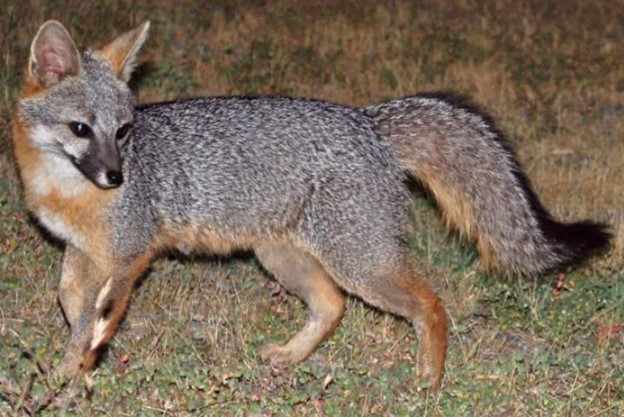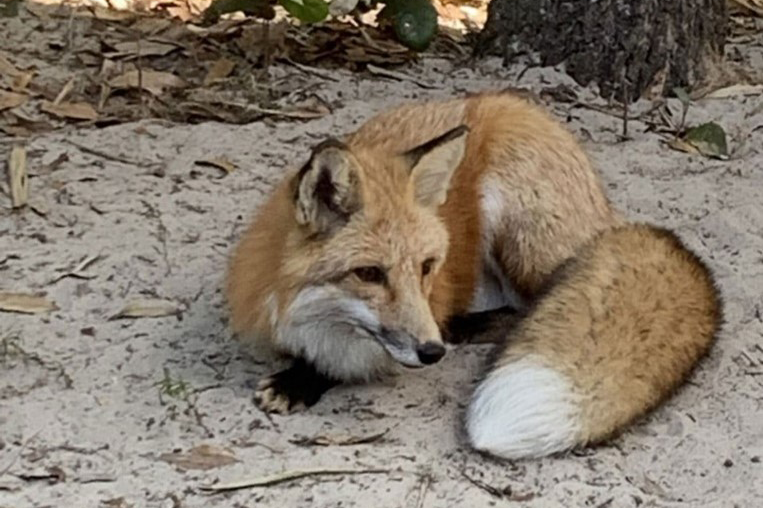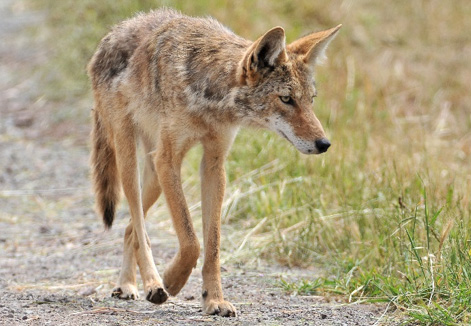Samantha M. Wisely, UF/IFAS Department of Wildlife Ecology and Conservation, University of Florida
The Panhandle of Florida has three species of canine wildlife: red fox, gray fox, and coyotes. Each species is unique in appearance and behavior, and each species has a unique history in Florida.
–
Gray fox (Urocyon cinereoargenteus floridanus)
This shy native fox is found in densely forested areas and is the smallest wild canid in Florida, weighing 7-13 lbs. As the name suggests, this fox has a gray or salt and pepper coat, but can have variable amounts of red in the coat, which can make it look similar to a red fox. Gray foxes can be distinguished from red foxes or coyotes by their cat-like faces, and they are the only canid with a black stripe running down the length of their tail.
Gray fox eat mice, rabbits, insects, fish, fruits and berries. Like other small-bodied carnivores, gray fox play an important role in keeping rodent populations under control, and therefore should not be considered nuisance animals. While it is not impossible for them to prey on poultry, it is rare given their propensity to live in dense forest.

Gray fox. The gray fox has a black stripe running down the length of its tail. Credit: Gary Robertson, Creative Commons
–
Red fox (Vulpes vulpes)
Red fox are native to the Panhandle, but have expanded their distribution to much of Florida both naturally and by human introduction for hunting. Red fox can be quite variable in coat color, but the dominant coat color in the Southeastern US is red/orange and less commonly gray or blond. They weigh between 10-15 lbs and can be distinguished from other Florida wild canids by their snow-white tail tip.
Red fox are carnivores but have a highly variable diet that can include garbage and domestic poultry. They are highly adaptable and can live in developed habitats like small farms and even suburban neighborhoods. The best way to protect poultry from red fox is to ensure that poultry are kept in pest-proof coups, especially at night. Red fox typically hunt at night; most daytime predators on free-ranging poultry are raccoons and bobcats. To keep red fox from being attracted to your farm, secure your garbage from wildlife raiders. Keeping garbage in wildlife proof containers will also reduce conflicts with bears and raccoons.

Red fox. The red fox has a snow-white tail tip. Photo used with permission and courtesy of Fox Tales Florida
–
Coyote (Canis latrans)
Coyotes have been present in the Panhandle since the 1960’s and have since expanded into all 67 counties of Florida. These large-bodied wild canids weigh between 20-35 lbs. Their coat can be a variable mixture of blonds, browns, gray, and black. They can be distinguished from foxes by their size, the robust shape of their head and snout, and by the black tip (not stripe) on their tail.
Coyotes are highly adaptable and can survive in almost any habitat. They also have a varied diet. In addition to eating rodents, rabbits, fruits, and berries, they prey on pets, deer fawns, small ruminant livestock and calves. The best management for reducing livestock mortalities is to prevent depredation before it occurs. Guard dogs, llamas and donkeys have been used with success; and for small farms, exclusion fencing can work. Coyote removal should be used as a management tool only when active livestock depredation has occurred. Indiscriminate removal of coyotes can actually increase the population of coyotes on your farm. By reducing established, dominant individuals, multiple subdominant males or additional packs can move onto the territory once held by dominant animals, which can magnify predation on livestock.
–
A note about sick or strangely behaving wild canids
Carnivores in the dog family, including foxes and coyotes are particularly susceptible to rabies. While rabies is mainly carried by bats and raccoons in Florida, the virus can be readily transmitted to wild canids. Coyotes or foxes that are active during the day, seem unafraid of or are aggressive to people, or appear disoriented, should be avoided and reported to authorities. Contact your local animal control office and report any occurrences of suspected rabid animals.
–
For more information check out these resources:
–
Mammalian Carnivores of Florida
–
Wildlife of Florida Factsheet: Coyotes
–
Using coyotes to protect livestock. Wait. What?
–
Guard animals for goats
–
Information about legal hunting and trapping of wild canids in Florida
–
Facts about wildlife diseases: rabies
–
Florida Animal Control Agency locator
- Armadillo Biology, Management, and Disease in the Panhandle - February 21, 2025
- Crop Damage from Deer in the Panhandle - August 15, 2024
- Status Update on Wild Turkeys in the Panhandle - February 23, 2024

